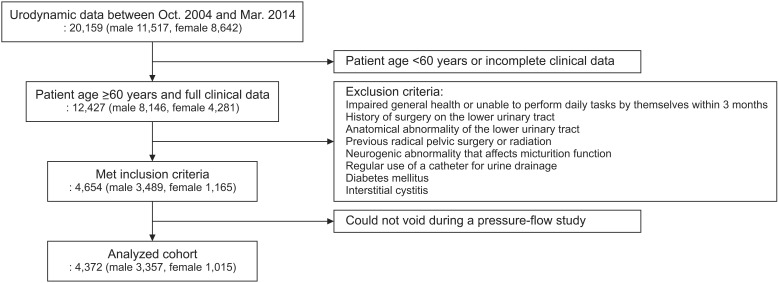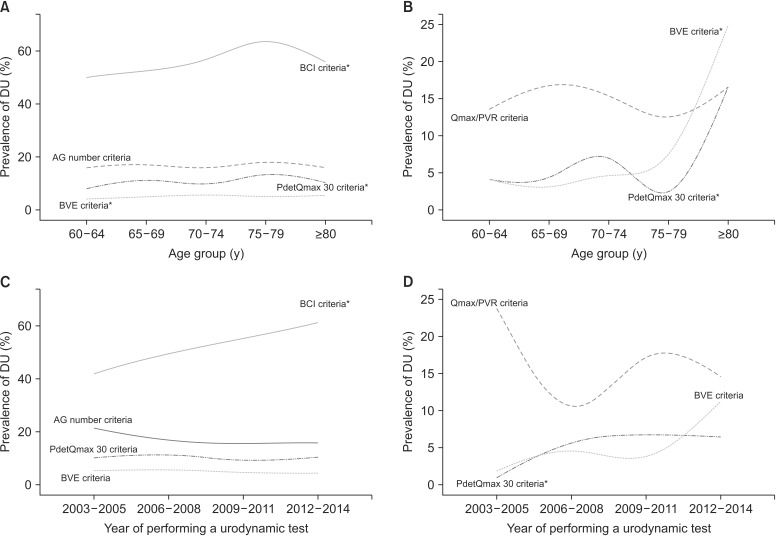Investig Clin Urol.
2017 Jul;58(4):247-254. 10.4111/icu.2017.58.4.247.
How do we diagnose detrusor underactivity? Comparison of diagnostic criteria based on an urodynamic measure
- Affiliations
-
- 1Department of Urology, Seoul National University College of Medicine, Seoul, Korea. sjo@snu.ac.kr
- 2Department of Urology, Seoul National University Bundang Hospital, Seongnam, Korea.
- 3Department of Urology, Seoul Metropolitan Government-Seoul National University Boramae Medical Center, Seoul, Korea.
- 4Department of Urology, Seoul National University Hospital, Seoul, Korea.
- KMID: 2410291
- DOI: http://doi.org/10.4111/icu.2017.58.4.247
Abstract
- PURPOSE
To compare several contemporary urodynamic criteria for diagnosing detrusor underactivity (DU) and estimate how well they coincide with each other.
MATERIALS AND METHODS
From our prospective urodynamic database we identified nonneurogenic lower urinary tract symptoms (LUTS) patients older than 60 years between 2003 and 2014. Patients were reclassified based on four and three contemporary criteria for DU among men and women. Each criterion was compared with the others using the McNemar test.
RESULTS
Urodynamic data of 4,372 patients (3,357 men and 1,015 women) were analyzed. In men, the prevalence of DU was estimated to be 56%, 17%, 5%, and 10% based on bladder contractility index, Abrams-Griffith number, maximal detrusor pressure at maximal flow rate (PdetQmax) 30, and bladder voiding efficiency (BVE) criteria. In women, 14.9%, 9.6%, and 6.4% of patients were classified as having DU based on maximal flow rate/postvoid residual (Qmax/PVR), PdetQmax 30, and BVE criteria. For individual subjects, all 4 criteria for men were significantly different from each other, while PdetQmax 30 and BVE criteria for women did not differ significantly (p=0.065). Additionally, BVE criterion for men and PdetQmax 30 and BVE criteria for women could distinguish the differences of patient age, free Qmax and free PVR between patient with and without DU.
CONCLUSIONS
Each urodynamic criterion for men does not coincide with each other in the diagnosis of DU within individual subjects. On the other hand, PdetQmax 30 criteria and BVE criteria for women could be appropriately applied to clinical practice when diagnosing DU in women with LUTS.
Keyword
MeSH Terms
Figure
Reference
-
1. Osman NI, Chapple CR, Abrams P, Dmochowski R, Haab F, Nitti V, et al. Detrusor underactivity and the underactive bladder: a new clinical entity? A review of current terminology, definitions, epidemiology, aetiology, and diagnosis. Eur Urol. 2014; 65:389–398. PMID: 24184024.
Article2. Jeong SJ, Kim HJ, Lee YJ, Lee JK, Lee BK, Choo YM, et al. Prevalence and clinical features of detrusor underactivity among elderly with lower urinary tract symptoms: a comparison between men and women. Korean J Urol. 2012; 53:342–348. PMID: 22670194.
Article3. Abrams P, Cardozo L, Fall M, Griffiths D, Rosier P, Ulmsten U, et al. The standardisation of terminology in lower urinary tract function: report from the standardisation sub-committee of the International Continence Society. Urology. 2003; 61:37–49. PMID: 12559262.
Article4. Abrams P. Bladder outlet obstruction index, bladder contractility index and bladder voiding efficiency: three simple indices to define bladder voiding function. BJU Int. 1999; 84:14–15. PMID: 10444116.
Article5. Nitti VW, Lefkowitz G, Ficazzola M, Dixon CM. Lower urinary tract symptoms in young men: videourodynamic findings and correlation with noninvasive measures. J Urol. 2002; 168:135–138. PMID: 12050507.
Article6. Abarbanel J, Marcus EL. Impaired detrusor contractility in community-dwelling elderly presenting with lower urinary tract symptoms. Urology. 2007; 69:436–440. PMID: 17382138.
Article7. Groutz A, Gordon D, Lessing JB, Wolman I, Jaffa A, David MP. Prevalence and characteristics of voiding difficulties in women: are subjective symptoms substantiated by objective urodynamic data? Urology. 1999; 54:268–272. PMID: 10443723.
Article8. Gammie A, Kaper M, Dorrepaal C, Kos T, Abrams P. Signs and symptoms of detrusor underactivity: an analysis of clinical presentation and urodynamic tests from a large group of patients undergoing pressure flow studies. Eur Urol. 2016; 69:361–369. PMID: 26318706.
Article9. Schäfer W, Abrams P, Liao L, Mattiasson A, Pesce F, Spangberg A, et al. Good urodynamic practices: uroflowmetry, filling cystometry, and pressure-flow studies. Neurourol Urodyn. 2002; 21:261–274. PMID: 11948720.
Article10. Tubaro A, La Vecchia C. Uroscreening Study Group. The relation of lower urinary tract symptoms with life-style factors and objective measures of benign prostatic enlargement and obstruction: an Italian survey. Eur Urol. 2004; 45:767–772. PMID: 15149750.
Article
- Full Text Links
- Actions
-
Cited
- CITED
-
- Close
- Share
- Similar articles
-
- The Clinical Significance of Detrusor Contraction Duration as a Predicting Parameter for Evaluaing Bladder Outlet Obstruction with Lower Urinary Symptoms in Men
- Influences on Voiding Symptoms of Pubovaginal Sling on Patients with Stress Urinary Incontinence with Detrusor Underactivity
- Potassium-Titanyl-Phosphate Laser Photoselective Vaporization of the Prostate in Patients with Benign Prostatic Hyperplasia with Detrusor Underactivity: Influence on Detrusor Pressure
- Underactive Bladder: Clinical Features, Urodynamic Parameters, and Treatment
- Comparison between Natural Filling Cystometry and Conventional Retrograde Filling Cystometry in Patients with Stroke



